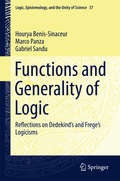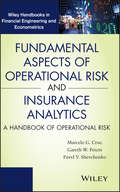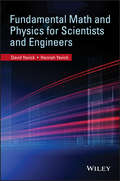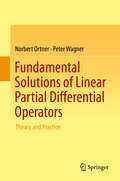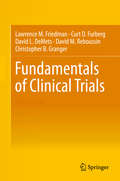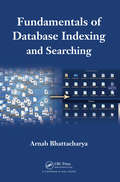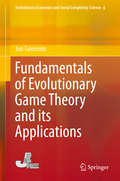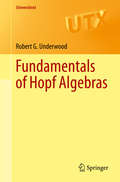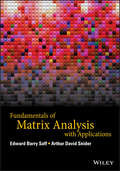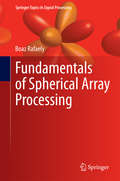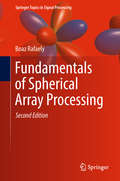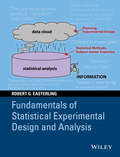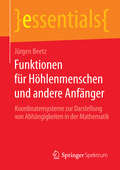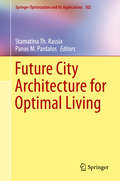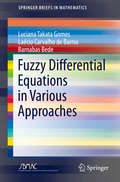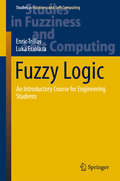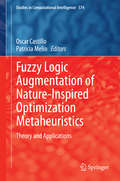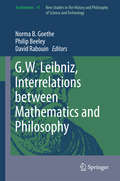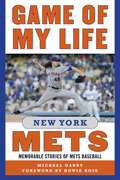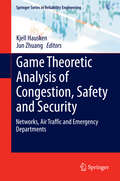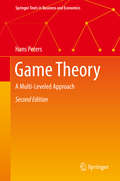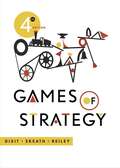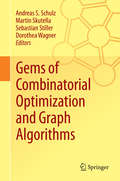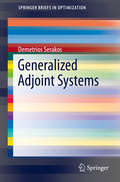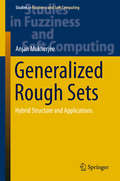- Table View
- List View
Functions and Generality of Logic
by Hourya Benis-Sinaceur Marco Panza Gabriel SanduThis book examines three connected aspects of Frege's logicism: the differences between Dedekind's and Frege's interpretation of the term 'logic' and related terms and reflects on Frege's notion of function, comparing its understanding and the role it played in Frege's and Lagrange's foundational programs. It concludes with an examination of the notion of arbitrary function, taking into account Frege's, Ramsey's and Russell's view on the subject. Composed of three chapters, this book sheds light on important aspects of Dedekind's and Frege's logicisms. The first chapter explains how, although he shares Frege's aim at substituting logical standards of rigor to intuitive imports from spatio-temporal experience into the deductive presentation of arithmetic, Dedekind had a different goal and used or invented different tools. The chapter highlights basic dissimilarities between Dedekind's and Frege's actual ways of doing and thinking. The second chapter reflects on Frege's notion of a function, in comparison with the notions endorsed by Lagrange and the followers of the program of arithmetization of analysis. It remarks that the foundational programs pursued by Lagrange and Frege are crucially different and based on a different idea of what the foundations of mathematics should be like. However, despite this contrast, the notion of function plays similar roles in the two programs, and this chapter emphasizes the similarities. The third chapter traces the development of thinking about Frege's program in the foundations of mathematics, and includes comparisons of Frege's, Russell's and Ramsey's views. The chapter discusses earlier papers written by Hintikka, Sandu, Demopoulos and Trueman. Although the chapter's main focus is on the notion of arbitrary correlation, it starts out by discussing some aspects of the connection between this notion and Dedekind Theorem.
Fundamental Aspects of Operational Risk and Insurance Analytics
by Marcelo G. Cruz Pavel V. Shevchenko Gareth W. PetersA one-stop guide for the theories, applications, andstatistical methodologies essential to operational riskProviding a complete overview of operational risk modeling andrelevant insurance analytics, Fundamental Aspects of OperationalRisk and Insurance Analytics: A Handbook of Operational Riskoffers a systematic approach that covers the wide range of topicsin this area. Written by a team of leading experts in the field,the handbook presents detailed coverage of the theories,applications, and models inherent in any discussion of thefundamentals of operational risk, with a primary focus on BaselII/III regulation, modeling dependence, estimation of risk models,and modeling the data elements.Fundamental Aspects of Operational Risk and Insurance Analytics:A Handbook of Operational Risk begins with coverage on the fourdata elements used in operational risk framework as well asprocessing risk taxonomy. The book then goes further in-depth intothe key topics in operational risk measurement and insurance, forexample diverse methods to estimate frequency and severity models.Finally, the book ends with sections on specific topics, such asscenario analysis; multifactor modeling; and dependence modeling. Aunique companion with Advances in Heavy Tailed Risk Modeling: AHandbook of Operational Risk, the handbook also features:Discussions on internal loss data and key risk indicators,which are both fundamental for developing a risk-sensitiveframeworkGuidelines for how operational risk can be inserted into afirm's strategic decisionsA model for stress tests of operational risk under the UnitedStates Comprehensive Capital Analysis and Review (CCAR)programA valuable reference for financial engineers, quantitativeanalysts, risk managers, and large-scale consultancy groupsadvising banks on their internal systems, the handbook is alsouseful for academics teaching postgraduate courses on themethodology of operational risk.
Fundamental Math and Physics for Scientists and Engineers
by Hannah Yevick David YevickThis text summarizes the core undergraduate physics curriculum together with the mathematics frequently encountered in engineering and physics calculations, focusing on content relevant to practical applications.Covers major undergraduate physics topics including the complete Physics GRE subject examination syllabusOverview of key results in undergraduate applied mathematics and introduces scientific programmingPresents simple, coherent derivations and illustrations of fundamental concepts
Fundamental Solutions of Linear Partial Differential Operators
by Norbert Ortner Peter WagnerThis monograph provides the theoretical foundations needed for the construction of fundamental solutions and fundamental matrices of (systems of) linear partial differential equations. Many illustrative examples also show techniques for finding such solutions in terms of integrals. Particular attention is given to developing the fundamentals of distribution theory, accompanied by calculations of fundamental solutions. The main part of the book deals with existence theorems and uniqueness criteria, the method of parameter integration, the investigation of quasihyperbolic systems by means of Fourier and Laplace transforms, and the representation of fundamental solutions of homogeneous elliptic operators with the help of Abelian integrals. In addition to rigorous distributional derivations and verifications of fundamental solutions, the book also shows how to construct fundamental solutions (matrices) of many physically relevant operators (systems), in elasticity, thermoelasticity, hexagonal/cubic elastodynamics, for Maxwell's system and others. The book mainly addresses researchers and lecturers who work with partial differential equations. However, it also offers a valuable resource for students with a solid background in vector calculus, complex analysis and functional analysis.
Fundamentals of Clinical Trials
by Lawrence M. Friedman Curt D. Furberg David L. DeMets David M. Reboussin Christopher B. GrangerThis is the fifth edition of a very successful textbook on clinical trials methodology, written by recognized leaders who have long and extensive experience in all areas of clinical trials. The three authors of the first four editions have been joined by two others who add great expertise. A chapter on regulatory issues has been included and the chapter on data monitoring has been split into two and expanded. Many contemporary clinical trial examples have been added. There is much new material on adverse events, adherence, issues in analysis, electronic data, data sharing and international trials.This book is intended for the clinical researcher who is interested in designing a clinical trial and developing a protocol. It is also of value to researchers and practitioners who must critically evaluate the literature of published clinical trials and assess the merits of each trial and the implications for the care and treatment of patients. The authors use numerous examples of published clinical trials to illustrate the fundamentals.The text is organized sequentially from defining the question to trial closeout. One chapter is devoted to each of the critical areas to aid the clinical trial researcher. These areas include pre-specifying the scientific questions to be tested and appropriate outcome measures, determining the organizational structure, estimating an adequate sample size, specifying the randomization procedure, implementing the intervention and visit schedules for participant evaluation, establishing an interim data and safety monitoring plan, detailing the final analysis plan and reporting the trial results according to the pre-specified objectives.Although a basic introductory statistics course is helpful in maximizing the benefit of this book, a researcher or practitioner with limited statistical background would still find most if not all the chapters understandable and helpful. While the technical material has been kept to a minimum, the statistician may still find the principles and fundamentals presented in this text useful.
Fundamentals of Database Indexing and Searching
by Arnab BhattacharyaFundamentals of Database Indexing and Searching presents well-known database searching and indexing techniques. It focuses on similarity search queries, showing how to use distance functions to measure the notion of dissimilarity.After defining database queries and similarity search queries, the book organizes the most common and representative ind
Fundamentals of Evolutionary Game Theory and its Applications
by Jun TanimotoThis book both summarizes the basic theory of evolutionary games and explains their developing applications, giving special attention to the 2-player, 2-strategy game. This game, usually termed a "2×2 game" in the jargon, has been deemed most important because it makes it possible to posit an archetype framework that can be extended to various applications for engineering, the social sciences, and even pure science fields spanning theoretical biology, physics, economics, politics, and information science. The 2×2 game is in fact one of the hottest issues in the field of statistical physics. The book first shows how the fundamental theory of the 2×2 game, based on so-called replicator dynamics, highlights its potential relation with nonlinear dynamical systems. This analytical approach implies that there is a gap between theoretical and reality-based prognoses observed in social systems of humans as well as in those of animal species. The book explains that this perceived gap is the result of an underlying reciprocity mechanism called social viscosity. As a second major point, the book puts a sharp focus on network reciprocity, one of the five fundamental mechanisms for adding social viscosity to a system and one that has been a great concern for study by statistical physicists in the past decade. The book explains how network reciprocity works for emerging cooperation, and readers can clearly understand the existence of substantial mechanics when the term "network reciprocity" is used. In the latter part of the book, readers will find several interesting examples in which evolutionary game theory is applied. One such example is traffic flow analysis. Traffic flow is one of the subjects that fluid dynamics can deal with, although flowing objects do not comprise a pure fluid but, rather, are a set of many particles. Applying the framework of evolutionary games to realistic traffic flows, the book reveals that social dilemma structures lie behind traffic flow.
Fundamentals of Hopf Algebras
by Robert G. UnderwoodThis text aims to provide graduate students with a self-contained introduction to topics that are at the forefront of modern algebra, namely, coalgebras, bialgebras and Hopf algebras. The last chapter (Chapter 4) discusses several applications of Hopf algebras, some of which are further developed in the author's 2011 publication, An Introduction to Hopf Algebras. The book may be used as the main text or as a supplementary text for a graduate algebra course. Prerequisites for this text include standard material on groups, rings, modules, algebraic extension fields, finite fields and linearly recursive sequences. The book consists of four chapters. Chapter 1 introduces algebras and coalgebras over a field K; Chapter 2 treats bialgebras; Chapter 3 discusses Hopf algebras and Chapter 4 consists of three applications of Hopf algebras. Each chapter begins with a short overview and ends with a collection of exercises which are designed to review and reinforce the material. Exercises range from straightforward applications of the theory to problems that are devised to challenge the reader. Questions for further study are provided after selected exercises. Most proofs are given in detail, though a few proofs are omitted since they are beyond the scope of this book.
Fundamentals of Matrix Analysis with Applications
by Edward Barry Saff Arthur David SniderAn accessible and clear introduction to linear algebra with a focus on matrices and engineering applications Providing comprehensive coverage of matrix theory from a geometric and physical perspective, Fundamentals of Matrix Analysis with Applications describes the functionality of matrices and their ability to quantify and analyze many practical applications. Written by a highly qualified author team, the book presents tools for matrix analysis and is illustrated with extensive examples and software implementations. Beginning with a detailed exposition and review of the Gauss elimination method, the authors maintain readers’ interest with refreshing discussions regarding the issues of operation counts, computer speed and precision, complex arithmetic formulations, parameterization of solutions, and the logical traps that dictate strict adherence to Gauss’s instructions. The book heralds matrix formulation both as notational shorthand and as a quantifier of physical operations such as rotations, projections, reflections, and the Gauss reductions. Inverses and eigenvectors are visualized first in an operator context before being addressed computationally. Least squares theory is expounded in all its manifestations including optimization, orthogonality, computational accuracy, and even function theory. Fundamentals of Matrix Analysis with Applications also features: Novel approaches employed to explicate the QR, singular value, Schur, and Jordan decompositions and their applications Coverage of the role of the matrix exponential in the solution of linear systems of differential equations with constant coefficients Chapter-by-chapter summaries, review problems, technical writing exercises, select solutions, and group projects to aid comprehension of the presented concepts Fundamentals of Matrix Analysis with Applications is an excellent textbook for undergraduate courses in linear algebra and matrix theory for students majoring in mathematics, engineering, and science. The book is also an accessible go-to reference for readers seeking clarification of the fine points of kinematics, circuit theory, control theory, computational statistics, and numerical algorithms.
Fundamentals of Spherical Array Processing
by Boaz RafaelyThis book provides a comprehensive introduction to the theory and practice of spherical microphone arrays. It is written for graduate students, researchers and engineers who work with spherical microphone arrays in a wide range of applications. The first two chapters provide the reader with the necessary mathematical and physical background, including an introduction to the spherical Fourier transform and the formulation of plane-wave sound fields in the spherical harmonic domain. The third chapter covers the theory of spatial sampling, employed when selecting the positions of microphones to sample sound pressure functions in space. Subsequent chapters present various spherical array configurations, including the popular rigid-sphere-based configuration. Beamforming (spatial filtering) in the spherical harmonics domain, including axis-symmetric beamforming, and the performance measures of directivity index and white noise gain are introduced, and a range of optimal beamformers for spherical arrays, including beamformers that achieve maximum directivity and maximum robustness, and the Dolph-Chebyshev beamformer are developed. The final chapter discusses more advanced beamformers, such as MVDR and LCMV, which are tailored to the measured sound field.
Fundamentals of Spherical Array Processing (Springer Topics In Signal Processing Ser. #8)
by Boaz RafaelyThis book provides a comprehensive introduction to the theory and practice of spherical microphone arrays, and was written for graduate students, researchers and engineers who work with spherical microphone arrays in a wide range of applications. The new edition includes additions and modifications, and references supplementary Matlab code to provide the reader with a straightforward start for own implementations. The book is also accompanied by a Matlab manual, which explains how to implement the examples and simulations presented in the book.The first two chapters provide the reader with the necessary mathematical and physical background, including an introduction to the spherical Fourier transform and the formulation of plane-wave sound fields in the spherical harmonic domain. In turn, the third chapter covers the theory of spatial sampling, employed when selecting the positions of microphones to sample sound pressure functions in space. Subsequent chapters highlight various spherical array configurations, including the popular rigid-sphere-based configuration. Beamforming (spatial filtering) in the spherical harmonics domain, including axis-symmetric beamforming, and the performance measures of directivity index and white noise gain are introduced, and a range of optimal beamformers for spherical arrays, including those that achieve maximum directivity and maximum robustness are developed, along with the Dolph–Chebyshev beamformer. The final chapter discusses more advanced beamformers, such as MVDR (minimum variance distortionless response) and LCMV (linearly constrained minimum variance) types, which are tailored to the measured sound field.
Fundamentals of Statistical Experimental Design and Analysis
by Robert G. EasterlingProfessionals in all areas - business; government; the physical, life, and social sciences; engineering; medicine, etc. - benefit from using statistical experimental design to better understand their worlds and then use that understanding to improve the products, processes, and programs they are responsible for. This book aims to provide the practitioners of tomorrow with a memorable, easy to read, engaging guide to statistics and experimental design. This book uses examples, drawn from a variety of established texts, and embeds them in a business or scientific context, seasoned with a dash of humor, to emphasize the issues and ideas that led to the experiment and the what-do-we-do-next? steps after the experiment. Graphical data displays are emphasized as means of discovery and communication and formulas are minimized, with a focus on interpreting the results that software produce. The role of subject-matter knowledge, and passion, is also illustrated. The examples do not require specialized knowledge, and the lessons they contain are transferrable to other contexts. Fundamentals of Statistical Experimental Design and Analysis introduces the basic elements of an experimental design, and the basic concepts underlying statistical analyses. Subsequent chapters address the following families of experimental designs: Completely Randomized designs, with single or multiple treatment factors, quantitative or qualitative Randomized Block designs Latin Square designs Split-Unit designs Repeated Measures designs Robust designs Optimal designs Written in an accessible, student-friendly style, this book is suitable for a general audience and particularly for those professionals seeking to improve and apply their understanding of experimental design.
Funktionen für Höhlenmenschen und andere Anfänger: Koordinatensysteme zur Darstellung von Abhängigkeiten in der Mathematik (essentials)
by Jürgen BeetzFunktionen und Koordinatensysteme spielen in der Mathematik eine wichtige Rolle - und im täglichen Leben auch. Meist merken wir es gar nicht oder sind uns über die mathematischen Hintergründe von Grafiken gar nicht klar, die wir in den Medien sehen. Deswegen werden in diesem Essential die Grundlagen dieser bedeutenden Werkzeuge des Denkens dargestellt und ihre Verwendung illustriert. Da dazu auch ihr Missbrauch gehört, wird auch das Thema ,,Lügen mit Grafiken" behandelt: falsche Maßstäbe, Unterdrückung des Nullpunkts, unsinnige Extrapolationen und schließlich Fehler in den Zahlen selbst.
Future City Architecture for Optimal Living (Springer Optimization and Its Applications #102)
by Stamatina Th. Rassia Panos M. PardalosThis book offers a wealth of interdisciplinary approaches to urbanization strategies in architecture centered on growing concerns about the future of cities and their impacts on essential elements of architectural optimization, livability, energy consumption and sustainability. It portrays the urban condition in architectural terms, as well as the living condition in human terms, both of which can be optimized by mathematical modeling as well as mathematical calculation and assessment.Special features include: • new research on the construction of future cities and smart cities• discussions of sustainability and new technologies designed to advance ideas to future city developmentsGraduate students and researchers in architecture, engineering, mathematical modeling, and building physics will be engaged by the contributions written by eminent international experts from a variety of disciplines including architecture, engineering, modeling, optimization, and related fields.
Fuzzy Differential Equations in Various Approaches
by Luciana Takata Gomes Laécio Carvalho de Barros Barnabas BedeThis book may be used as reference for graduate students interested in fuzzy differential equations and researchers working in fuzzy sets and systems, dynamical systems, uncertainty analysis, and applications of uncertain dynamical systems. Beginning with a historical overview and introduction to fundamental notions of fuzzy sets, including different possibilities of fuzzy differentiation and metric spaces, this book moves on to an overview of fuzzy calculus thorough exposition and comparison of different approaches. Innovative theories of fuzzy calculus and fuzzy differential equations using fuzzy bunches of functions are introduced and explored. Launching with a brief review of essential theories, this book investigates both well-known and novel approaches in this field; such as the Hukuhara differentiability and its generalizations as well as differential inclusions and Zadeh's extension. Through a unique analysis, results of all these theories are examined and compared.
Fuzzy Logic
by Enric Trillas Luka EciolazaThis book introduces readers to fundamental concepts in fuzzy logic. It describes the necessary theoretical background and a number of basic mathematical models. Moreover, it makes them familiar with fuzzy control, an important topic in the engineering field. The book offers an unconventional introductory textbook on fuzzy logic, presenting theory together with examples and not always following the typical mathematical style of theorem-corollaries. Primarily intended to support engineers during their university studies, and to spark their curiosity about fuzzy logic and its applications, the book is also suitable for self-study, providing a valuable resource for engineers and professionals who deal with imprecision and non-random uncertainty in real-world applications.
Fuzzy Logic Augmentation of Nature-Inspired Optimization Metaheuristics
by Oscar Castillo Patricia MelinThis book describes recent advances on fuzzy logic augmentation of nature-inspired optimization metaheuristics and their application in areas such as intelligent control and robotics, pattern recognition, time series prediction and optimization of complex problems. The book is organized in two main parts, which contain a group of papers around a similar subject. The first part consists of papers with the main theme of theoretical aspects of fuzzy logic augmentation of nature-inspired optimization metaheuristics, which basically consists of papers that propose new optimization algorithms enhanced using fuzzy systems. The second part contains papers with the main theme of application of optimization algorithms, which are basically papers using nature-inspired techniques to achieve optimization of complex optimization problems in diverse areas of application.
G.W. Leibniz, Interrelations between Mathematics and Philosophy
by Norma B. Goethe Philip Beeley David RabouinUp to now there have been scarcely any publications on Leibniz dedicated to investigating the interrelations between philosophy and mathematics in his thought. In part this is due to the previously restricted textual basis of editions such as those produced by Gerhardt. Through recent volumes of the scientific letters and mathematical papers series of the Academy Edition scholars have obtained a much richer textual basis on which to conduct their studies - material which allows readers to see interconnections between his philosophical and mathematical ideas which have not previously been manifested. The present book draws extensively from this recently published material. The contributors are among the best in their fields. Their commissioned papers cover thematically salient aspects of the various ways in which philosophy and mathematics informed each other in Leibniz's thought.
Game of My Life New York Mets: Memorable Stories of Mets Baseball (Game Of My Life Ser.)
by Michael Garry Howie RoseGame of My Life New York Mets, now newly updated, takes a personal look inside the biggest moments of the Mets’ greatest and most beloved players, from journeymen to superstars. Their most unforgettable games paint a picture of Mets history, as the franchise morphed from a dismal (though lovable) expansion team in 1962 to World Series Champions in 1969 and 1986 and then back to basement dwellers before meeting the Yankees in the 2000 Subway Series, and the Royals in a surprise appearance in the 2015 World Series. Fan favorite Ron Swoboda recounts making “The Catch.” Infielder Wally Backman relives the many thrills of playing on the ’86 Mets as they marched to a championship. All-Star Edgardo Alfonzo describes going six-for-six, including three home runs, in one of the most dominating offensive games in baseball history. Right-hander Bobby Jones recalls pitching the most dominating postseason game in Mets history, when he threw a one-hit shutout to clinch the 2000 National League Division Series against the San Francisco Giants. Current ace Jacob deGrom recounts his gritty series-clinching performance against the Dodgers in Game Five of the NLDS. Journalist Michael Garry, a lifelong Mets fan, also includes stories about Tom Seaver, Mike Piazza, and David Wright, among others.
Game Theoretic Analysis of Congestion, Safety and Security
by Jun Zhuang Kjell HauskenMaximizing reader insights into the interactions between game theory, excessive crowding and safety and security elements, this book establishes a new research angle by illustrating linkages between different research approaches and through laying the foundations for subsequent analysis. Congestion (excessive crowding) is defined in this work as all kinds of flows; e. g. , road/sea/air traffic, people, data, information, water, electricity, and organisms. Analysing systems where congestion occurs - which may be in parallel, series, interlinked, or interdependent, with flows one way or both ways - this book puts forward new congestion models, breaking new ground by introducing game theory and safety/security into proceedings. Addressing the multiple actors who may hold different concerns regarding system reliability; e. g. one or several terrorists, a government, various local or regional government agencies, or others with stakes for or against system reliability, this book describes how governments and authorities may have the tools to handle congestion, but that these tools need to be improved whilst additionally ensuring safety and security against various threats. This game-theoretic analysis sets this book apart from the current congestion literature and ensures that the book will be of use to postgraduates, researchers, 3rd/4th-year undergraduates, policy makers, and practitioners.
Game Theory
by Hans PetersThis textbook presents the basics of game theory both on an undergraduate level and on a more advanced mathematical level. It is the second, revised version of the successful 2008 edition. The book covers most topics of interest in game theory, including cooperative game theory. Part I presents introductions to all these topics on a basic yet formally precise level. It includes chapters on repeated games, social choice theory, and selected topics such as bargaining theory, exchange economies, and matching. Part II goes deeper into noncooperative theory and treats the theory of zerosum games, refinements of Nash equilibrium in strategic as well as extensive form games, and evolutionary games. Part III covers basic concepts in the theory of transferable utility games, such as core and balancedness, Shapley value and variations, and nucleolus. Some mathematical tools on duality and convexity are collected in Part IV. Every chapter in the book contains a problem section. Hints, answers and solutions are included.
Games of Strategy
by Avinash K. Dixit Susan Skeath David H. ReileyGames of Strategy, famous for its simple yet accurate exposition and its great examples and exercises, has been extensively revised for this Fourth Edition. The key to its broad success is that the authors assume no prior knowledge of game theory and present the material in the most accessible way possible. With new and improved features and compelling end-of-chapter exercises, this Fourth Edition of Games of Strategy continues to engage students around the world.
Gems of Combinatorial Optimization and Graph Algorithms
by Dorothea Wagner Sebastian Stiller Martin Skutella Andreas S. SchulzAre you looking for new lectures for your course on algorithms, combinatorial optimization, or algorithmic game theory? Maybe you need a convenient source of relevant, current topics for a graduate student or advanced undergraduate student seminar? Or perhaps you just want an enjoyable look at some beautiful mathematical and algorithmic results, ideas, proofs, concepts, and techniques in discrete mathematics and theoretical computer science? Gems of Combinatorial Optimization and Graph Algorithms is a handpicked collection of up-to-date articles, carefully prepared by a select group of international experts, who have contributed some of their most mathematically or algorithmically elegant ideas. Topics include longest tours and Steiner trees in geometric spaces, cartograms, resource buying games, congestion games, selfish routing, revenue equivalence and shortest paths, scheduling, linear structures in graphs, contraction hierarchies, budgeted matching problems, and motifs in networks. This volume is aimed at readers with some familiarity of combinatorial optimization, and appeals to researchers, graduate students, and advanced undergraduate students alike.
Generalized Adjoint Systems
by Demetrios SerakosThis book defines and develops the generalized adjoint of an input-output system. It is the result of a theoretical development and examination of the generalized adjoint concept and the conditions under which systems analysis using adjoints is valid. Results developed in this book are useful aids for the analysis and modeling of physical systems, including the development of guidance and control algorithms and in developing simulations. The generalized adjoint system is defined and is patterned similarly to adjoints of bounded linear transformations. Next the elementary properties of the generalized adjoint system are derived. For a space of input-output systems, a generalized adjoint map from this space of systems to the space of generalized adjoints is defined. Then properties of the generalized adjoint map are derived. Afterward the author demonstrates that the inverse of an input-output system may be represented in terms of the generalized adjoint. The use of generalized adjoints to determine bounds for undesired inputs such as noise and disturbance to an input-output system is presented and methods which parallel adjoints in linear systems theory are utilized. Finally, an illustrative example is presented which utilizes an integral operator representation for the system mapping.
Generalized Rough Sets
by Anjan MukherjeeThe book introduces the concept of "generalized interval valued intuitionistic fuzzy soft sets". It presents the basic properties of these sets and also, investigates an application of generalized interval valued intuitionistic fuzzy soft sets in decision making with respect to interval of degree of preference. The concept of "interval valued intuitionistic fuzzy soft rough sets" is discussed and interval valued intuitionistic fuzzy soft rough set based multi criteria group decision making scheme is presented, which refines the primary evaluation of the whole expert group and enables us to select the optimal object in a most reliable manner. The book also details concept of interval valued intuitionistic fuzzy sets of type 2. It presents the basic properties of these sets. The book also introduces the concept of "interval valued intuitionistic fuzzy soft topological space (IVIFS topological space)" together with intuitionistic fuzzy soft open sets (IVIFS open sets) and intuitionistic fuzzy soft closed sets (IVIFS closed sets).
